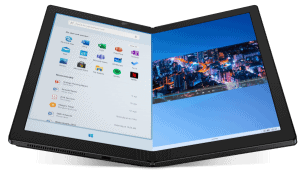MEF CEO Dario Betti shares his key take-aways from CES 2020:
- Devices: more foldable screens, 5G makes inroads in PCs
- A new mobile video service: Quibi has an impressive pedigree…
- IoT vs Security & Privacy: another breach, another scandal
- The new generation of games consoles are coming, expect 8K.
CES is of course, not a mobile focused event, and telecom professionals might find they have to fight their way through super-fast wine chillers, AI enabled food mixers, companion robots that run IoT devices in the home, and new dangerous transport models (the prototype Segway pod crashed on a wall).

And yet, there are nuggets of tech to be found and related trends to uncover that could have strong repercussions on the mobile ecosystem.
Foldable Devices – with Windows
CES is an important barometer for trends in devices. Lenovo presented the ThinkPad X1 Fold, a truly foldable PC, that links the PC/Tablet/Phone factors. The foldable screen concept is on the rise. The success was also for Windows 10X, the operating software is extending its reach in the PC area for foldables.
 Foldable phones were already a big theme at MWC – foldables are really emerging as a strong theme in the innovation in device form factors. These might be the first steps still, but the quality and the interaction models are growing.
Foldable phones were already a big theme at MWC – foldables are really emerging as a strong theme in the innovation in device form factors. These might be the first steps still, but the quality and the interaction models are growing.
Quibi – the new bet on mobile content
A new streaming service would not receive much interest nowadays, after the success of Netflix many have joined the market including Apple and Disney most recently. However, the launch of Quibi has raised plenty of interest. The mobile only video streaming service will selling from the 6th of April in the USA, with a cost of $5 per month for an ad-based solution, and $8 for the ad free version.
T-Mobile will bundle Quibi with some of its services. The content will be created with mobile users in mind: specifically designed to be short (four to ten minutes) and supporting the mobile screen functionalities (touch screen, gyroscope, cameras etc). The founder of the venture is Jeffrey Katzenberg, a legend in the industry for his success at Walt Disney and Dreamworks.
Investors in the start up include The Walt Disney Company, Liberty Global and Viacom. The pedigree is very impressive, but others have tried mobile video content services before with little success. The omens are not good: Verizon launched the Go90 mobile streaming services in 2015 but stopped it in July 2018, after spending about 1.2 billion USD on it.
5G laptops are coming
5G had plenty of device announcements, as expected. There is little excitement surrounding the devices per-se, but mostly the attention goes to the number of devices showed and the overall price range.
T-Mobile launched its 5G network at the event, and it showed two 5G phone for its 600 MHz band. AT&T will increase its 5G line up from 1 device to 15 devices supporting it low band 5G service during 2020. Verizon promised a line-up of 20 different 5G devices in the year, including devices in the 600-800 USD range – reaching mass market prices for the USA market. The actual coverage of 5G in the USA is still in its very early phases, it seems that this time devices supply is more than adequate for the next generation launch.
The real news in 5G? Lenovo presented what they called the first 5G laptop: the Lenovo Yoga 5G, powered by Qualcomm’s Snapdragon 8cx platform that will see 5G support included from its release in March. Instead the Dell Latitude 95 and the HP Elite Dragonfly G2 will be offered with 5G as an option.
Ring – a reminder for IoT security issues
 The Amazon owned video doorbell system was grilled by US senators just on the opening day of CES. Ring devices had been hacked in the past weeks and a news stories grew about the security issues with the home security devices. AT CES the company introduced a new privacy and security solution requiring a two-factor authentication for its new products. The company still faces a federal lawsuit and a class action lawsuit for allegedly failing to protect its users.
The Amazon owned video doorbell system was grilled by US senators just on the opening day of CES. Ring devices had been hacked in the past weeks and a news stories grew about the security issues with the home security devices. AT CES the company introduced a new privacy and security solution requiring a two-factor authentication for its new products. The company still faces a federal lawsuit and a class action lawsuit for allegedly failing to protect its users.
Sony is sensing a new way
Sony presents its first car, but the electric model was supposed to be only an illustration of the possible applications for Sony Imaging and sensor business. Sony will not build cars, but it intends to be a supplier of technology to the automotive industry.
The Japanese manufacturer is looking for a new lease of life from industrial applications for its sensors; it placed 33 of them in the prototype car. Similarly, Audio Analytics, a UK start up showed a second generation of audio recognition: a library that can recognise from the audio what is happening: making technology aware of its surroundings like a human would be.
The emergence in sensors and technology is welcome, but it still not balanced by an understanding or a framework to limit its impact on privacy and surveillance.
8K TVs for gaming
Indirectly the emergence of 8K (the next higher definition for TV after 4K) is good news for the telecom industry: the heavier the definition the higher the bandwidth required to be delivered for streaming services. The higher definitions will realistically be perceived on screens that are 70 inches or wider. This is the sweet spot for the 8K, but not a huge mass market.
However, there are 2 million of these big screens expected to be shipped in 2020, a good start. And things might be changing though, thanks to the support of the enthusiast gamer community. The new Xbox Series X was announced before CES, and will be supporting 8K – the PlayStation 5 only presented its logo at CES. The rumours point at Sony also supporting the new standard in TV definition.





